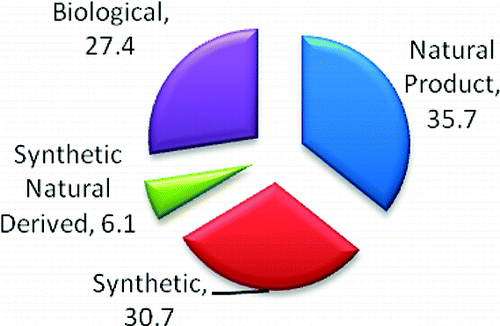Most new pesticides have roots in natural substances

Scientists who search for new pesticides for use in humanity's battle of the bugs and other threats to the food supply have been learning lessons from Mother Nature, according to a new analysis. It concludes that more than two out of every three new pesticide active ingredients approved in recent years had roots in natural substances produced in plants or animals. The article appears in ACS' Journal of Natural Products.
Charles L. Cantrell and colleagues point out that there have been many analyses of the impact of natural products – substances produced by living plants, animals and other organisms – on the production of pesticides. None, however, has ever looked at the impact of natural products and natural product-based pesticides in fostering new active ingredients (NAIs) in pesticides on the U.S. market, based on NAI registrations with the U.S. Environmental Protection Agency. The scientists filled that information gap with results that they say defy conventional wisdom that natural products may not be the best sources for NAIs.
The analysis found that between 1997 and 2010, more natural products were registered as NAIs for conventional pesticides and biopesticides than any other type of ingredient. The authors report that when biological ingredients and natural products recreated in labs are included, more than 69 percent of all NAIs registered in that time frame have natural origins.
More information: "Natural Products As Sources for New Pesticides” J. Nat. Prod., 2012, 75 (6), pp 1231–1242. DOI: 10.1021/np300024u
Abstract
Natural products as pesticides have been reviewed from several perspectives in the past, but no prior treatment has examined the impact of natural product and natural product-based pesticides on the U.S. market, as a function of new active ingredient registrations with the Environmental Protection Agency (EPA). Thus, EPA registration details of new active ingredients for all conventional pesticide registrations and biopesticide registrations were compiled from the years 1997–2010. Conventional pesticide registrations and biopesticide registrations were examined both collectively and independently for all 277 new active ingredients (NAI) and subsequently categorized and sorted into four types: biological (B), natural product (NP), synthetic (S), and synthetic natural derived (SND). When examining conventional pesticides alone, the S category accounted for the majority of NAI registrations, with 78.0%, followed by SND with 14.7%, NP with 6.4%, and B with 0.9%. Biopesticides alone were dominated by NPs with 54.8%, followed by B with 44.6%, SND with 0.6%, and 0% for S. When examining conventional pesticides and biopesticides combined, NPs accounted for the majority of NAI registrations, with 35.7%, followed by S with 30.7%, B with 27.4%, and SND with 6.1%. Despite the common perception that natural products may not be the best sources for NAI as pesticides, when both conventional and biopesticides are examined collectively, and considering that NP, SND, and B all have origins from natural product research, it can be argued that their combined impact with the EPA from 1997 to 2010 accounted for 69.3% of all NAI registrations.
Journal information: Journal of Natural Products
Provided by American Chemical Society

















